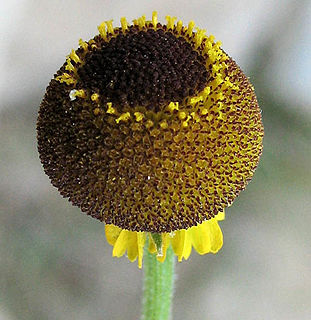Related Research Articles

Lycopersicon was a genus in the flowering plant family Solanaceae. It contained about 13 species in the tomato group of nightshades. First removed from the genus Solanum by Philip Miller in 1754, its removal leaves the latter genus paraphyletic, so modern botanists generally accept the names in Solanum. The name Lycopersicon is still used by gardeners, farmers, and seed companies. Collectively, the species in this group apart from the common cultivated plant are called wild tomatoes.
Lepidium puberulum is an annual herb in the family Brassicaceae, endemic to the west coast of Western Australia. The species has white or green flowers that appear from July to November in its native range.

Helenium puberulum is a North American species of flowering plants in the daisy family known by the common name rosilla. It is native to California and Baja California, where it can be found in moist habitats such as riverbanks and meadows. It has also been found in Oregon, although these might possibly be naturalized populations.

Allium roseum, commonly called rosy garlic, is an edible, Old World species of wild garlic. It is native to the Mediterranean region and nearby areas, with a natural range extending from Portugal and Morocco to Turkey and the Palestine region. It is cultivated widely, and has become naturalised in scattered locations in other regions outside its natural range.
Cryptosepalum exfoliatum is a species of tree native to tropical Africa. It is the dominant tree species in the Zambezian cryptosepalum dry forest ecoregion of Zambia and Angola, where it is known locally as "mavunda". Cryptosepalum exfoliatum forests form habitat for the butterfly Mylothris mavunda.
Nemaschema chlorizans is a species of beetle in the family Cerambycidae. It was described by Fauvel in 1906.
Nemaschema griseum is a species of beetle in the family Cerambycidae. It was described by Fauvel in 1906.
Nemaschema lineatum is a species of beetle in the family Cerambycidae. It was described by Fauvel in 1906.
Nemaschema macilentum is a species of beetle in the family Cerambycidae. It was described by Fauvel in 1906.
Nemaschema nitidulum is a species of beetle in the family Cerambycidae. It was described by Fauvel in 1906.
Nemaschema limbicolle is a species of beetle in the family Cerambycidae. It was described by Fauvel in 1906.
Nemaschema collarti is a species of beetle in the family Cerambycidae. It was described by Stephan von Breuning in 1958.
Nemaschema flavovittatum is a species of beetle in the family Cerambycidae. It was described by Stephan von Breuning in 1976.
Nemaschema ochreovittatum is a species of beetle in the family Cerambycidae. It was described by Stephan von Breuning in 1978.
Nemaschema olivaceum is a species of beetle in the family Cerambycidae. It was described by Stephan von Breuning in 1950.
Nemaschema quadrisulcatum is a species of beetle in the family Cerambycidae. It was described by Stephan von Breuning in 1940. It is known from New Caledonia.
Nemaschema lamberti is a species of beetle in the family Cerambycidae. It was described by Xavier Montrouzier in 1861.
Nemaschema mulsanti is a species of beetle in the family Cerambycidae. It was described by Perroud in 1864.
Nemaschema sanguinicolle is a species of beetle in the family Cerambycidae. It was described by Chevrolat in 1858.

Teucrium puberulum, commonly known as red berry stick plant, is a species of flowering plant in the family Lamiaceae, and is endemic to inland areas of eastern Australia. It is an erect shrub covered with star-shaped hairs, and with linear to lance-shaped leaves, greenish-white flowers and reddish fruit.
References
- ↑ "Nemaschema puberulum". BioLib. Retrieved 8 September 2014.